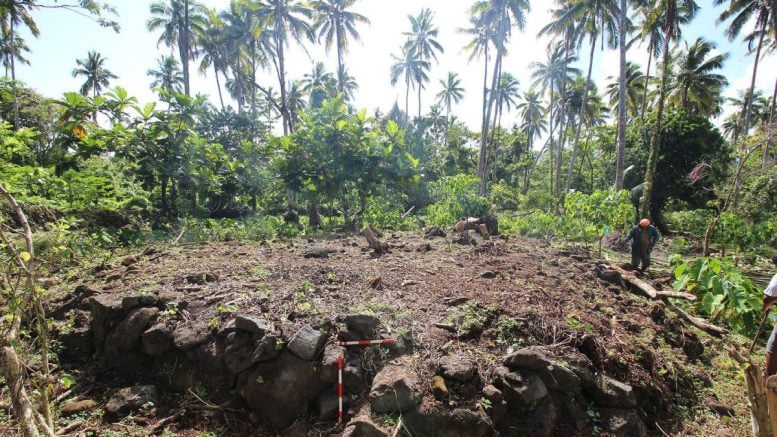Ancient Structures Unearthed in Sāmoa Offer Clues to Origins of Inequality


Archaeological research in Samoa has uncovered ancient structures that highlight early social stratification and land management strategies, offering a deeper understanding of Polynesian cultural development. Large mound found in Saoluafata, Sāmoa. Credit: University of Auckland
A new study led by archaeologists at the University of Auckland may have revealed the origins of hierarchical society in Sāmoa and throughout Polynesia.
New research reveals that the recent uncovering of ancient rock walls, towering mounds, and deep ditches in the thick jungles of the Falefa Valley on ʻUpolu Island in Sāmoa offers important insights into the roots of land ownership and social stratification in Polynesian culture.
Led by Associate Professor Ethan Cochrane from Waipapa Taumata Rau, University of Auckland, the study makes new connections between a dramatic rise in population in Sāmoa, richer agricultural land in certain areas, and the beginnings of land demarcation and associated social status.
These connections have been of great interest to ordinary Sāmoans, says Cochrane.
“They have the most intimate knowledge of their land possible and are now able to compare ancient political and village boundaries revealed through archaeology with modern boundaries, and those known through oral tradition, and see where the differences lie.”
The team’s fieldwork in Sāmoa hinged around LiDAR (Light Detection and Ranging), a mapping technology that uses light in the form of a pulsed laser to measure variable distances to Earth, from which it creates a topographic map.
Crucially, says Cochrane, when you fly it from a plane, LiDAR penetrates small gaps in thick foliage to reveal what would otherwise have been covered up by a forest canopy.
“This technology has been used for the past 15 to 20 years around the Pacific, and the great thing it can do is strip away even a dense jungle environment. This is one of the first times it’s been used in Sāmoa, so all these impressive rock walls, platforms, and mounds, which date back between 600 and 900 years, can be seen in precise detail.”
Field Challenges and Architectural Discoveries
Macheting through dense bush in pouring rain and scorching sun, being attacked by mosquitoes at every turn, very much in “Indiana Jones archaeology” mode, says Cochrane, might not be for everyone, but the rewards, in this case, make any discomfort worthwhile.
“These structures up close are incredible pieces of architecture. Some were family dwellings made from stone and earth, just like you see today in some Sāmoan villages, others would have been civic construction projects or ceremonial projects. Some are what are called ‘star mounds’, as high as two meters, and possibly used for standing on to snare pigeons, which was a chiefly sport.”
The study, which was carried out in partnership with the National University of Samoa, and the permission of local villages, is not the first to find these structures, but it is the first to connect the timing and reasons for building them with what it refers to as a ‘collective action problem’, he says.

Associate Professor Ethan Cochrane in the field, Falefa Valley, ʻUpolu Island, Sāmoa. Credit: University of Auckland
“We’ve figured out that this building of stuff – kilometer-long rock walls that limit access to land, ditches for irrigation to create a productive wetland agricultural system – is a response to a massive population rise in Sāmoa that we know happened around that time [from 900 years ago].”
“In this instance, sharing resources with everyone would mean less for everyone, so the problem becomes, ‘when does it become advantageous for individuals to contribute to collective defense at a cost to themselves and to exclude other groups from access to the group’s resources?’”
After this rapid population rise in the valley, he says, people did exactly that; they fenced areas away from others to preserve their own access to a valuable resource.
“In this case, the earliest massive rock walls are near more fertile land in the western and northern regions of the valley, which we know to be true from analyzing soil samples in the area of these structures.”
It’s possible that the whole Samoan chiefly system, which is seen across Polynesian society generally, was established based on who had access to land in those early times, and who didn’t, says Cochrane, and this could also have been the reason for similar changes in early societies worldwide.
“We’ve often wondered why hierarchical societies arose across the planet over millennia, when around 20,000 years ago, most human societies were more equitable and there were fewer positions of status and power among hunter-gatherers.
“Now, however, we live at the other extreme where many societies, if not all, have status, hierarchies, and levels where some people have unimaginable power and others have nothing.”
Reference: “Collective action problems led to the cultural transformation of Sāmoa 800 years ago” by Ethan E. Cochrane, Seth Quintus, Matthew Prebble, Ta‘iao Aumua Ausilafa‘i Matiu Tautunu, Dolly Autufuga, Mana Laumea, Alexandra Queenin, Paul Augustinus and Noa Kekuewa Lincoln, 20 June 2024, PLOS ONE.
DOI: 10.1371/journal.pone.0304850

